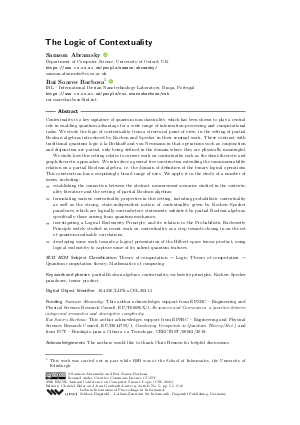LIPIcs.CSL.2021.5.pdf
- Filesize: 0.59 MB
- 18 pages

 Creative Commons Attribution 3.0 Unported license
Creative Commons Attribution 3.0 Unported license

Contextuality is a key signature of quantum non-classicality, which has been shown to play a central role in enabling quantum advantage for a wide range of information-processing and computational tasks. We study the logic of contextuality from a structural point of view, in the setting of partial Boolean algebras introduced by Kochen and Specker in their seminal work. These contrast with traditional quantum logic à la Birkhoff and von Neumann in that operations such as conjunction and disjunction are partial, only being defined in the domain where they are physically meaningful. We study how this setting relates to current work on contextuality such as the sheaf-theoretic and graph-theoretic approaches. We introduce a general free construction extending the commeasurability relation on a partial Boolean algebra, i.e. the domain of definition of the binary logical operations. This construction has a surprisingly broad range of uses. We apply it in the study of a number of issues, including: - establishing the connection between the abstract measurement scenarios studied in the contextuality literature and the setting of partial Boolean algebras; - formulating various contextuality properties in this setting, including probabilistic contextuality as well as the strong, state-independent notion of contextuality given by Kochen-Specker paradoxes, which are logically contradictory statements validated by partial Boolean algebras, specifically those arising from quantum mechanics; - investigating a Logical Exclusivity Principle, and its relation to the Probabilistic Exclusivity Principle widely studied in recent work on contextuality as a step towards closing in on the set of quantum-realisable correlations; - developing some work towards a logical presentation of the Hilbert space tensor product, using logical exclusivity to capture some of its salient quantum features.







Feedback for Dagstuhl Publishing